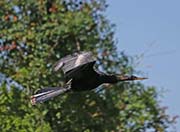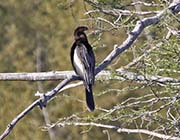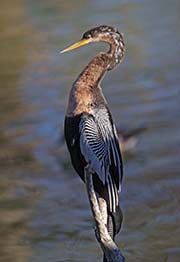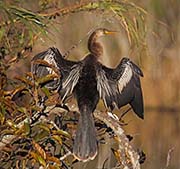Breeding (Feb-June)

Male
04/21/2012 - Brazos Bend State Park, TX
Male
04/21/2012 - Brazos Bend State Park, TX
|

Female
03/02/2009 - Jungle Gardens/Avery Island, Lousiana
Female
03/02/2009 - Jungle Gardens/Avery Island, Lousiana
|

Male (forefront) & female
03/02/2009 - Jungle Gardens/Avery Island, Lousiana
Male (forefront) & female
03/02/2009 - Jungle Gardens/Avery Island, Lousiana
|

Male
03/05/2009 - Audubon Park, New Orleans, LA
Male
03/05/2009 - Audubon Park, New Orleans, LA
|
|
|
Non-breeding (July-Jan)

Note how flexible the Anhinga's female's neck is.
01/27/2012 - Audubon Zoo, New Orleans, LA
Note how flexible the Anhinga's female's neck is.
01/27/2012 - Audubon Zoo, New Orleans, LA
|

It is easy to see why they have been called "Snake Bird"
03/14/2013 - JN Ding Darling NWR, Sanibel Island, FL
It is easy to see why they have been called "Snake Bird"
03/14/2013 - JN Ding Darling NWR, Sanibel Island, FL
|

Won an Honorable Mention at the Berkeley Camera Club for this image
12/15/2010 - Royal Palm Visitor Center, Everglades, FL
Won an Honorable Mention at the Berkeley Camera Club for this image
12/15/2010 - Royal Palm Visitor Center, Everglades, FL
|

Female
12/15/2010 - Royal Palm Visitor Center, Everglades, FL
Female
12/15/2010 - Royal Palm Visitor Center, Everglades, FL
|

Female
11/13/2014 - Royal Palm Visitor Center, Everglades, FL
Female
11/13/2014 - Royal Palm Visitor Center, Everglades, FL
|
|
Diet:
Anhingas' use they bill to spear their prey such as fish and
other aquatic animals such as snakes, frogs, crustaceans, etc.
The structure of their neck aids in the spearing of prey.
After diving for food, they will dry their feathers by spreading
their wings.
Courtship:
Anhingas pair bonds can span multiple seasons.
Males courtship behavior initially
includes soaring flights and glides.
After selecting the nest site and starting to build the nest,
males' courtship behavior includes complex movements
of the head, neck, body and wings.
They will also bow and snap their bill and present twigs to potential mates.
After the pair bond, the nest is finished.
Nesting:
Anhingas nests are usually built in small colonies made up of
other Anhingas or with other birds such as
ibises, herons and egrets.
The male starts the nest in a tree fork usually near or over water.
The exterior is made of sticks and the nest is lined with leaves.
The female usually finishes making the nest.
Usually 2-5 eggs are laid asynchronously a day or two apart.
Since the female does not have a brood patch,
their feet are used to keep the eggs warm.
The chicks are altricial at (featherless and eyes closed) and they
need care from birth.
When the chicks are young, they are feed partly digested regurgitated food.
Habitat and Range:
In the United States, Anhingas breed in the south.
They are also found in Mexico. Cuba, and in South America, east of the Andes.
They prefer shallow fresh water lakes, rivers, marshes, swamps, etc.
Vocalization:
Anhingas are usually quiet outside the nest but will sometimes make
clicking and shrill rattling sounds.
In the nest, they make harsh croaks, rattles and grunts.
Before copulation, each sex produces a different explosive notes.
Plumage/Molt:
They have a partial moult before breeding and a complete moult
afterwards.
This complete moult means they are temporarily unable to fly.
Migration:
Anhingas that are found migrate at the extreme north and south of their range.
Tongue/feet:
Darters feet have four long, webbed toes which are useful for propelling them
through the water.
Their claws are long and curved which are used for perching and climbing up
to the perch.
Bibliography:
- Nelson, J. Bryan, Pelicans, Cormorants and their relatives,Oxford University Press, 2005
- del Hoyo, Josep, Elliott, Andrew, Sargatal, Jordi, et.al., Handbook of the Birds of the World,Lynx Edicions
- http://en.wikipedia.org The Free Encyclopedia, Accessed June 2012
- http://www.allaboutbirds.org The Cornell Lab of Ornithology All About Birds, Accessed June 2012
Top of Page











